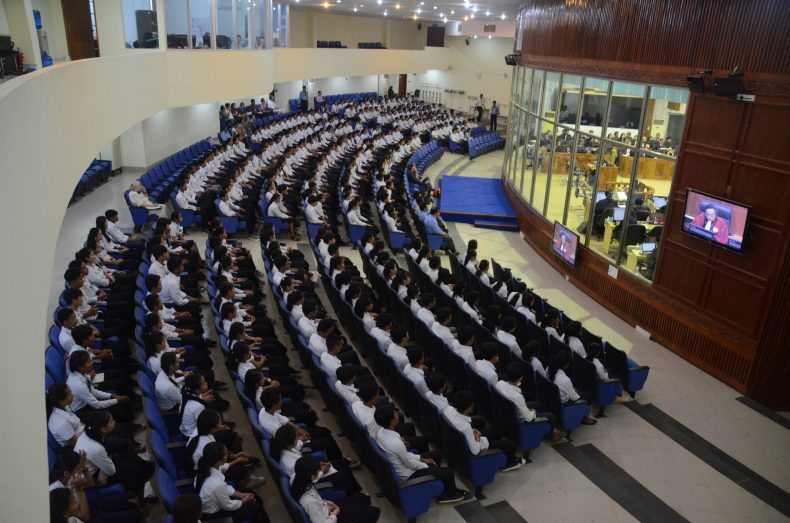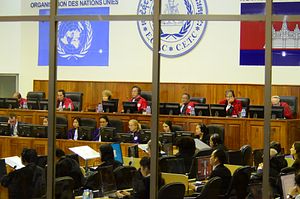The victims of the Khmer Rouge regime spent more than 30 years hoping, waiting, and praying for their day in court.
Survivors from the nightmare of the Khmer Rouge rule from 1975-79 at long last were able to witness their first glimpse of justice in 2010 with the conviction of Kaing Guek Euv aka Duch, the director of the S21 secret prison. Duch, who reported directly to senior leaders of the regime, masterminded the confessions extracted by all manner of torture — electric shock, waterboarding and being covered with angry, poisonous centipedes and scorpions — en route to the prisoners’ inescapable fate of execution.
The prison site was preserved by the Heng Samrin government, and opened to the public in 1980 as the Tuol Sleng Genocidal Museum.
When the guilty verdict came in the first trial, the cavernous public gallery, packed with Cambodian survivors still grieving over lost relatives, erupted with applause, relief, and a flood of tears.
Sovachana Pou, Senior Research Fellow at the Cambodian Institute for Cooperation and Peace (CICP) blogged at the time, (all sic) “I personally witnessed the hybrid justice proceeding live, with more than 500 people, most of them are victims. It was a moving experience and historic event for all the victims [who had] to wait more than 30 years to finally having some sort of justice.”
Pol Pot’s Khmer Rouge regime was ousted by Cambodian dissidents and Vietnamese regular troops in 1979. However, Cold War diplomacy led to the West’s complicity in supporting recognition of the exiled Khmer Rouge’s right to still represent the Cambodian people inside the UN General Assembly.
This Machiavellian diplomacy in support of the hated Khmer Rouge blocked UN recognition of the “Killing Fields” nightmare until 1997. Western ambassadors that I met in Bangkok in the 1980s and beyond predicted back then that a Cambodia tribunal would never take place.
After surmounting many hurdles, the Cambodian Tribunal, officially the Extraordinary Chamber in the Courts of Cambodia (ECCC), finally came into being in 2006, some 30 years after the mass graves were unearthed and evidence was made available from the Killing Fields of Cambodia. The tribunal was based on a partnership between the Cambodia government and the UN.
Under the Khmer Rouge regime that ruled Cambodia from 1975-79, two million people died as a result of mass executions and draconian policies that led to starvation, disease, and death in labor camps.
In its pursuit of justice, the ECCC Tribunal has secured all-important convictions against key leaders Nuon Chea, who ranked number two to supreme leader Pol Pot, and Khieu Samphan, the former head of state, judged to be part of the inner circle of Khmer Rouge decision-makers found guilty of crimes against humanity. They were both sentenced to life imprisonment in 2014.
David Scheffer, the UN secretary general’s special expert on UN assistance to the Khmer Rouge Trials, declared after the verdict, “Today, the winds of international justice swept through the fields, forests, and towns of Cambodia where millions perished.”
Hearings on a second part of the trial against already convicted leaders Nuon Chea and Khieu Samphan on charges of genocide, forced marriages, and sexual violence was recently completed.
The prosecution accused the Khmer Rouge regime of a deliberate policy of elimination targeting two ethnic minorities – the ethnic Cham and the Vietnamese. The judges have adjourned to consider their verdict on the genocide charges.
The ECCC, now in its final days or months, finds its legacy and achievements hotly disputed between international lawyers, journalists, academics, and human rights organizations.
From the very beginning the ECCC’s reputation was challenged by reports of corruption, poor management, and political interference. U.S.-based Human Rights Watch had always opposed the tribunal being held in Cambodia. Their damning report in 2014 alleged that “political interference, and corruption make [the] tribunal a failure.”
Many media adopted a similar theme. The New York Times ran with the headline: “11 Years, $300 Million and 3 Convictions. Was the Khmer Rouge Tribunal Worth It?” casting doubts over the tribunal’s performance. The ECCC trial prosecutor Nicholas Moumjian wrote a reply to The New York Times outlining a number of achievements that the Times’ piece had scarcely mentioned.
TIME Magazine in 2014 went much further with its denunciation of the Asia’s first-ever exercise in international justice as nothing but a “shocking failure.” (It should be noted that the piece was apparently filed out of Hong Kong, not Phnom Penh where the tribunal is based).
A common media narrative assumed that any tribunal based on partnership with Cambodia’s defective domestic courts, under the sway of long-serving Prime Minister Hun Sen, was doomed from the outset.
U.S. academic and Khmer Rouge specialist Alexander Hinton, whose new book The Trial of the Torturer is based on the Duch trial, observed, “There are valid concerns about politicization, cost, and the slow pace of the trial. But, despite all the difficulties, there have been fair trials leading to two judgements with a third on the way.”
The UN entered into the this hybrid tribunal on the understanding that UN assistance from highly experienced tribunal judges and prosecutors could ensure fair trials and international standards of justice, based on adding humanitarian law onto the body of Cambodian law and legal procedures.
Former UN legal affairs expert Lars Olsen, who traveled all over Cambodia during his seven year stint at the ECCC, recounted his experience to The Diplomat. “I met so many survivors to which the work of the tribunal mattered a great deal. All these encounters convinced me that the work of the tribunal matters to many survivors, and that the ECCC was their only hope to get some sense of justice.”
The political constraints, legal short-comings, and endless controversy are a common thread that runs through all previous tribunals for international justice and accountability.
According to Olsen, who was also the tribunal’s legal communications spokesman, “What the harshest critics often tend to forget is that the alternative to the ECCC is not a perfect tribunal, which would serve as a beacon of light in the world of international justice. On the contrary, the alternative would have been nothing at all.”

The Tribunal’s public gallery provided 500 seats and such was public interest it was often packed full. Photo by Khmer Rouge Tribunal (ECCC).
In Cambodia itself, the trials resonated with the public. As of July 2017, a total of 535,015 people had come to sit in the court room to watch the proceedings. Hundreds of thousands, if not millions, watched the daily live television broadcasts. Victims from all provinces have been provided free transport to attend the hearings so that justice could be watched first-hand.
The former secretary general of the UN, Ban Ki-Moon, called it “astounding,” saying that nothing like this level of public interest had been shown in other genocide trials.
The ECCC also established an important new legal precedent, with victims permitted to play an active role in the trial.
More than 3,800 civil parties registered in Case 002 against Nuon Chea and Khieu Samphan, making important contributions to the body of evidence and the court proceedings through their group lawyers. This unique role of victims as recognized parties in the Cambodia court, could well be adopted by future tribunals.
A group of 10 victims represented by the International Federation for Human Rights (FIDH) praised the court’s conviction of the former Khmer Rouge leaders on August 7, 2014. “We will finally be able to mourn our relatives,” they wrote. “It was important for us to see those who planned and ordered these crimes be held to account.”
Those who seek to belittle the credibility of tribunal frequently cite statistics comparing the Cambodian ECCC and its total of five indictments with 61 indictments from the former Yugoslavia and 95 from Rwanda (both cases prosecuted at the International Court Justice in The Hague) as well as 22 indictments from the Sierra Leone Special Court known as the Sierra Leone Tribunal. This fails to take into account the uniquely daunting obstacles that the Cambodian tribunal faced.
Hinton pointed out that some of the failings in the quest for justice are rightly blamed on the West. “Not only did the international community fail to seek to bring the Khmer Rouge to justice [from 1979 -1997], but they resupplied and rearmed the Khmer Rouge to fight a proxy war against the new Cambodian government,” Hinton said.
The exiled Khmer Rouge-controlled coalition, under the name of Democratic Kampuchea, occupied Cambodia’s seat in the UN General Assembly until 1990.
No previous genocide tribunal had been so systematically blocked and delayed by decades.
The 30-year delay clearly limited the number of Khmer Rouge leaders who could possibly be put on trial. Pol Pot, his top military commander Ta Mok, Foreign Minister Ieng Sary, and others died before the ECCC ever convened.
Now, Cases 003 and 004 are expected to be “shelved” given that funding is fast running out, and the Cambodian co-prosecutor and its legal enforcement arm have reportedly ceased cooperation apparently under pressure from Prime Minister Hun Sen.
Youk Chhang, the founder of DC-Cam (Documentation Center of Cambodia, focused on preserving records of the Khmer Rouge era) has accused the trial judges of “tarnishing justice” by terminating the remaining two cases.
But he strongly argues that, despite the tribunal’s flaws, there is overall a very positive legacy:
“Without the Khmer Rouge Tribunal, Cambodia would not be able to record and preserve the history of the Khmer Rouge regime for future generations and establish a critical foundation for the rule of law, which is very vital for national reconciliation in Cambodia.”
In 2009 the first history textbook about the Khmer Rouge rule, A History of Democratic Kampuchea, was introduced in Cambodia’s school curriculum
Cambodia can take satisfaction in being the first country in Asia to have bravely confronted the horrors of the darkest chapter in their history. The country has thus rendered all the other victims of mass atrocities still denied justice in the region an important service.
Tom Fawthrop first visited Cambodia in December 1980 as a correspondent for the Irish Times. He is the co-author of Getting Away with Genocide? Elusive Justice & the Khmer Rouge Tribunal and has reported on the Cambodia Tribunal for the Economist and the Guardian.

































